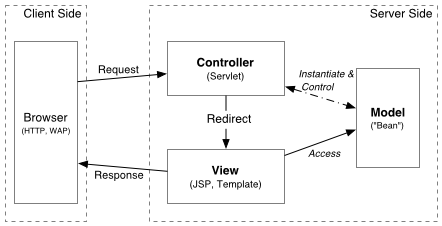| jwma's Architecture - Overview | |
| Main | Deployment | Configuration | Architecture | Development | Screenshots | SF Project Site | |
| Index | Overview | Model (M) | View (V) | Controller (C) | Other Elements | |
jwma is a living example of the JSP Model 2 architecture. It utilizes this
server side Model-View-Controller (MVC) design pattern, which is based on the
idea of seperating logic and presentation, for a server side mail client implementation.
Basically it works as follows:
The browser sends a request to the controller (e.g. Servlet), which instantiates
or controls the related model instances and redirects to the view
(e.g. JSP, Template) related to the request (see Figure 1). Thus the elements
can be described as:
A good and more in depth introduction to this architectural approach can be
found in a JavaWorld published article: "Understanding
JavaServer Pages Model 2 architecture".
 |
| Figure 1: JSP Model 2 Architecture |
To achieve a real seperation, the view (JSP or templates) should only
use accessor methods to retrieve data from the model for presentation.
jwma's model is specially designed to provide such a "view designer's perspective",
allowing to design (rather then program) views without complex embedded application
logic.
The following links point to more in depth documentation of the three main architectural
elements:
Additional architectural elements of jwma are the kernel and the plugins. These are described in the "Other Elements" document.
| © 2000-2003 jwma team |